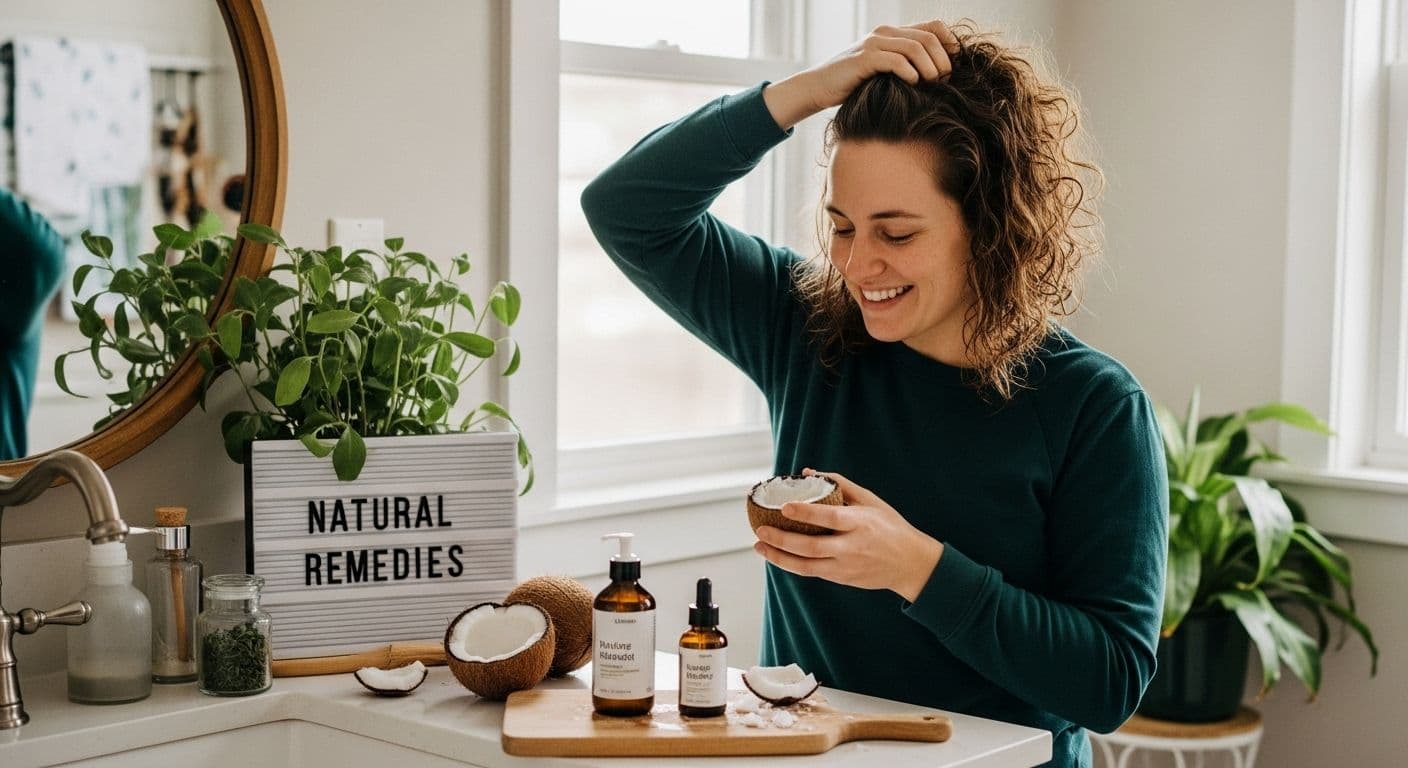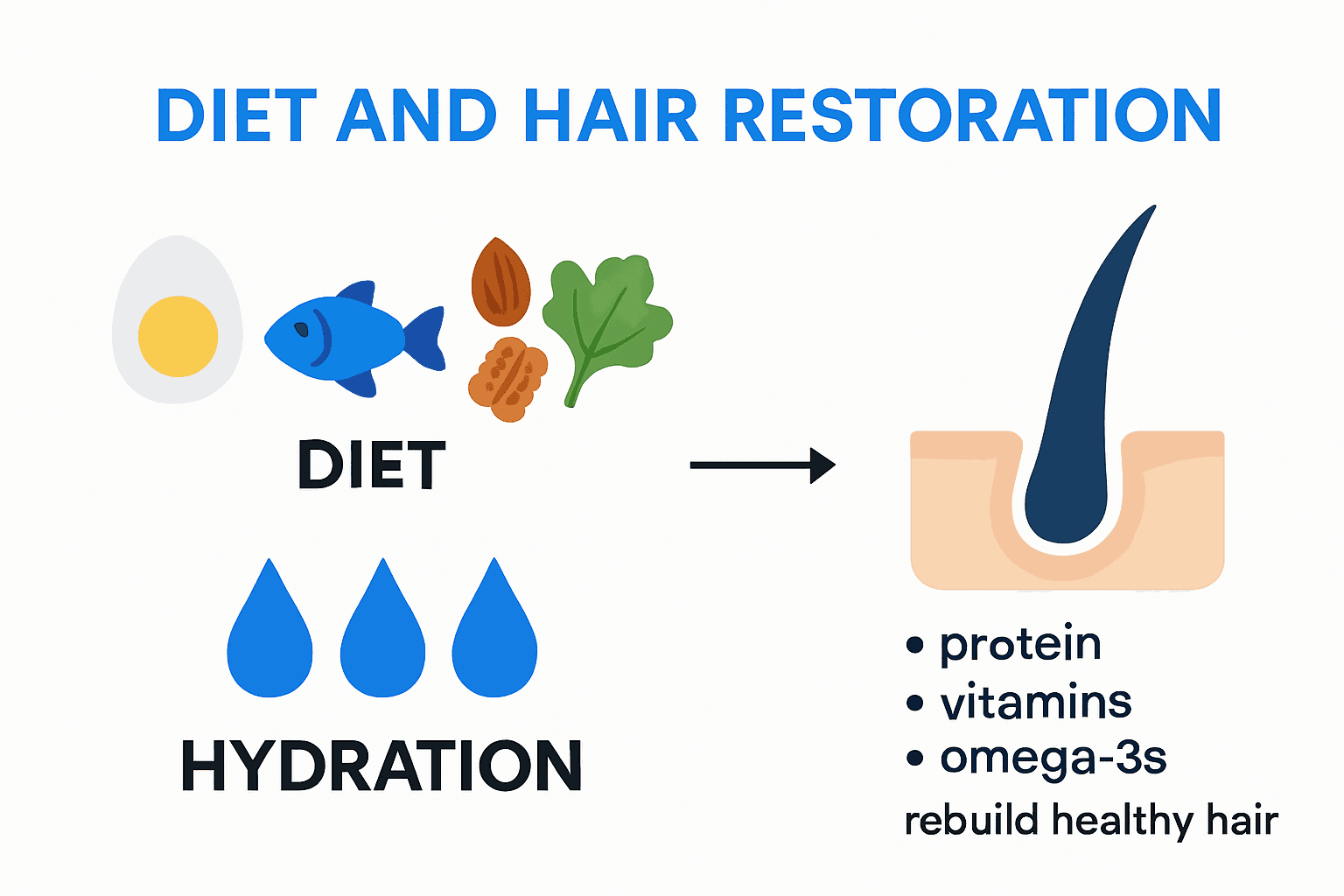Blog
Learning Materials
Best Natural Remedies for Damaged Hair: 2025 Guide
Updated: July 31, 2025

Damaged hair is a common headache for millions and it can leave you feeling frustrated after every look in the mirror. Yet while salons sell intricate fixes and pricey products, nature packs some seriously powerful solutions right in your kitchen. Shockingly, studies show coconut oil can reduce protein loss in hair by up to 39 percent compared to untreated strands. The best part is that restoring soft, healthy hair often comes down to simple habits and natural ingredients hiding in plain sight.
Table of Contents
- Understanding Causes of Damaged Hair
- Top Natural Remedies for Damaged Hair
- Customizing Hair Care for Growth and Repair
- Tips for Tracking Hair Health Progress
Quick Summary
| Takeaway | Explanation |
|---|---|
| Identify Hair Damage Causes | Understand that chemical treatments, lifestyle, and mechanical stress are principal contributors to hair damage. |
| Use Natural Oil Treatments | Coconut oil penetrates hair deeply, reducing protein loss and improving moisture retention. |
| Incorporate Nutritional Support | A balanced diet rich in proteins, vitamins, and hydration is crucial for healthy hair growth and repair. |
| Personalize Your Hair Care | Tailor hair care routines based on individual hair type and specific damage for effective restoration. |
| Track Hair Health Progress | Regularly document changes and metrics to monitor the effectiveness of hair care strategies over time. |
Understanding Causes of Damaged Hair
Hair damage is a complex issue that goes far beyond simple cosmetic concerns. Understanding the root causes helps individuals develop more effective strategies for hair restoration and protection. Natural remedies for damaged hair start with recognizing the underlying factors that contribute to hair deterioration.
Chemical Processing and Hair Structure Breakdown
Chemical treatments represent one of the most significant sources of hair damage. Research published in the National Center for Biotechnology Information reveals that procedures like bleaching, perming, relaxing, and straightening can cause substantial structural damage to hair fibers. These processes fundamentally alter the protein structure of hair, weakening its internal bonds and making it more susceptible to breakage.
The chemical processes strip away the hair's natural protective layers, leaving it vulnerable to environmental stressors. Repeated treatments compound this damage, creating a cascading effect where each chemical intervention further compromises hair integrity. Hair becomes progressively more brittle, prone to splitting, and loses its natural luster and resilience.
Environmental and Lifestyle Factors
According to the American Academy of Dermatology, everyday hair care practices can significantly contribute to hair damage. Common mistakes include aggressive washing techniques, skipping conditioner, rough towel drying, and excessive heat styling. UV radiation, pollution, and harsh weather conditions further stress hair strands, accelerating deterioration.
Lifestyle factors such as poor nutrition, stress, and hormonal imbalances also play crucial roles in hair health. Nutritional deficiencies can weaken hair from within, making it more susceptible to external damage. Chronic stress disrupts hair growth cycles, potentially leading to increased breakage and reduced hair quality.
Mechanical Stress and Hair Fragility
Physical manipulation of hair creates another significant avenue for damage. Tight hairstyles, frequent use of elastic bands, aggressive brushing, and improper detangling techniques can cause mechanical stress. This stress leads to cuticle damage, split ends, and incremental weakening of hair strands.
Understanding these causes empowers individuals to explore comprehensive hair restoration strategies. By recognizing the multifaceted nature of hair damage, people can adopt more holistic approaches to hair care that address root causes rather than merely treating surface-level symptoms.
To help readers compare and understand the main types of hair damage causes, here is a table summarizing the factors discussed in this section:
| Cause of Damage | Description | Examples |
|---|---|---|
| Chemical Processing | Alters hair’s protein structure and weakens internal bonds | Bleaching, perming, relaxing, straightening |
| Environmental/Lifestyle | Exposes hair to stressors, depleting natural protection | Sun, pollution, heat styling, poor nutrition |
| Mechanical Stress | Physical stress damages hair cuticle and structure | Tight hair ties, rough brushing, towel drying |
Top Natural Remedies for Damaged Hair
Natural remedies offer powerful solutions for restoring damaged hair without relying on harsh chemical treatments. By understanding the right approaches, individuals can effectively repair and strengthen their hair using ingredients found in nature.
Nourishing Oil Treatments
Healthline reports that coconut oil stands out as an exceptional natural remedy for damaged hair. This versatile oil penetrates hair fibers deeply, providing intense moisture and helping to repair structural damage. The oil's unique molecular structure allows it to actually enter the hair shaft, unlike many synthetic conditioners that simply coat the surface.
Coconut oil works by reducing protein loss and protecting hair from further damage. When applied consistently, it can help restore hair's natural shine, reduce breakage, and improve overall hair texture. For maximum benefits, individuals should warm the oil slightly and massage it into the scalp and hair strands, leaving it on for at least 30 minutes before washing.
Herbal and Plant-Based Hair Masks
Medical News Today highlights the potential of natural ingredients in supporting scalp health and hair restoration. Ingredients like aloe vera, avocado, honey, and egg yolk create powerful hair masks that address multiple aspects of hair damage. Aloe vera, for instance, contains enzymes that repair dead skin cells on the scalp and promote healthy hair growth.
A simple yet effective hair mask can be created by combining mashed avocado with honey and a tablespoon of olive oil. This combination provides proteins, vitamins, and essential fatty acids that nourish hair from root to tip. The mask helps seal moisture, reduce frizz, and improve hair elasticity. Users should apply such masks weekly for optimal results.
Dietary and Holistic Approaches

Natural hair restoration extends beyond topical treatments. Nutrition plays a crucial role in hair health, with certain foods directly supporting hair repair and growth. Protein-rich foods like eggs, fish, and legumes provide the building blocks for hair protein. Omega-3 fatty acids found in salmon, chia seeds, and walnuts help maintain scalp health and reduce inflammation.
Hydration is equally important. Drinking adequate water and consuming water-rich fruits and vegetables can improve hair moisture from within. Supplements like biotin, vitamin E, and iron can also support hair restoration when recommended by a healthcare professional.
Learn more about comprehensive hair restoration strategies that combine natural treatments with holistic approaches. By understanding the interconnected nature of hair health, individuals can develop personalized strategies that address damage at its root cause.
Customizing Hair Care for Growth and Repair
Effective hair care goes beyond generic solutions. Personalized approaches that consider individual hair type, damage level, and specific needs are crucial for successful hair restoration and growth. Understanding how to customize hair care strategies can transform damaged hair into healthy, resilient strands.
Identifying Your Hair's Unique Needs
Research from a 2025 systematic review emphasizes the critical role of nutritional balance in hair health. Identifying your specific hair challenges requires a comprehensive assessment of multiple factors. Nutritional deficiencies can significantly impact hair quality, making it essential to understand your body's unique requirements.
Different hair types respond differently to treatments. Fine, thin hair needs lightweight moisture, while thick, coarse hair requires more intensive hydration. Factors like scalp condition, hair porosity, and previous chemical treatments all influence the most appropriate care strategy. Conducting a thorough hair and scalp analysis helps develop a targeted approach that addresses specific damage and growth challenges.
Herbal Remedies and Targeted Treatments
A comprehensive review of herbal plants reveals a treasure trove of natural solutions for hair care. Plants like Amla, Bhringraj, Hibiscus, and Rosemary offer unique benefits for different hair concerns. Amla, for instance, is renowned for strengthening hair follicles, while Hibiscus can help prevent premature graying and support hair growth.
A study from North West Saudi Arabia highlighted the versatility of natural ingredients. Home remedies like yogurt, eggs, and honey can be powerful tools in addressing hair damage. The key is to create personalized combinations that target specific hair issues. For example, individuals with dry, brittle hair might benefit from egg and olive oil masks, while those with oily scalps could use yogurt and lemon treatments.
To clarify the different natural remedies and their intended benefits, the following table summarizes key options and their targeted effects:
| Remedy/Ingredient | Main Benefit(s) | Best For |
|---|---|---|
| Coconut Oil | Reduces protein loss, deep moisture | All hair types, dry/damaged |
| Aloe Vera | Repairs scalp, promotes growth | Irritated/dry scalp |
| Avocado + Honey Mask | Nourishes, seals in moisture | Brittle, frizzy hair |
| Egg & Olive Oil Mask | Strengthens, adds shine | Dry/brittle hair |
| Yogurt & Lemon Treatment | Balances oil, soothes scalp | Oily scalp, greasy hair |
| Amla/Bhringraj/Hibiscus | Strengthens follicles, supports growth | Weak, thinning hair |
Holistic Approach to Hair Restoration
Successful hair care requires a holistic approach that combines external treatments with internal health strategies. Diet plays a crucial role in hair growth and repair. Protein-rich foods, vitamins A and C, iron, and omega-3 fatty acids support hair follicle health and promote stronger, more resilient hair.
Stress management, adequate hydration, and proper sleep are equally important. Chronic stress can disrupt hair growth cycles, while insufficient sleep and dehydration can compromise hair quality. Creating a comprehensive care routine that addresses both physical and emotional well-being is essential for optimal hair health.
Learn more about personalized hair restoration techniques that can help you develop a tailored approach to hair care. By understanding the intricate relationship between nutrition, lifestyle, and hair health, you can create a customized strategy that promotes long-term hair growth and repair.
Tips for Tracking Hair Health Progress
Monitoring hair health is a critical aspect of successful hair restoration and damage prevention. Effective tracking allows individuals to understand their hair's progress, identify potential issues early, and adjust their care strategies accordingly. By implementing systematic observation techniques, anyone can become more proactive about their hair health.
Documenting Visual Changes
Harvard Health highlights the importance of understanding nutritional impacts on hair health. Visual documentation serves as a powerful tool for tracking hair progress. Individuals should create a comprehensive hair journal that includes monthly photographs taken under consistent lighting and from the same angles. These images can reveal subtle changes in hair thickness, shine, and overall texture that might be difficult to notice day-to-day.
Key visual indicators to track include hair density, scalp condition, shine levels, and the presence of split ends. Using a standardized measurement technique, such as photographing specific sections of hair against a neutral background, helps create a reliable baseline for comparison. Digital tools and smartphone apps can assist in maintaining consistent documentation and analyzing subtle changes over time.
Measuring Hair Health Metrics
The American Academy of Dermatology recommends several quantitative methods for tracking hair health. These include measuring hair strand thickness, tracking hair growth rate, and monitoring hair breakage. A simple at-home method involves carefully collecting shed hair during washing and comparing the number and condition of hair strands over time.
Specific metrics to track include:
- Hair Length: Measure monthly growth
- Hair Thickness: Use digital calipers or specialized hair thickness measurement tools
- Breakage Rate: Count and analyze shed hairs
- Scalp Health: Observe scalp condition and any changes in texture or appearance
To make it easy to review the recommended hair health metrics, here is a summary table:
| Metric | How to Track | Purpose |
|---|---|---|
| Hair Length | Measure monthly | Assess growth rate |
| Hair Thickness | Use calipers/tools | Monitor hair strength |
| Breakage Rate | Count/analyze shed hairs | Track hair fragility |
| Scalp Health | Visual and tactile inspection | Identify skin and health changes |
Nutritional and Lifestyle Tracking
WebMD suggests that hair health is deeply connected to overall nutrition and lifestyle factors. Creating a comprehensive tracking system that includes dietary intake, stress levels, sleep quality, and hair care routines can provide invaluable insights into hair restoration progress.
Develop a holistic tracking approach by maintaining a detailed log that includes:
- Daily nutrient intake
- Hydration levels
- Stress management techniques
- Sleep duration and quality
- Hair care routine modifications
Technology can play a significant role in this process. Many health and nutrition tracking apps now offer features that can help monitor these interconnected factors. Explore advanced hair health tracking methods to gain deeper insights into your hair restoration journey. By combining visual documentation, quantitative measurements, and lifestyle tracking, individuals can create a comprehensive approach to understanding and improving their hair health.

Frequently Asked Questions
What are the best natural remedies for damaged hair?
Natural remedies for damaged hair include nourishing oils like coconut oil, herbal hair masks using ingredients such as aloe vera and avocado, and a balanced diet rich in proteins and vitamins to support hair health.
How does coconut oil help repair damaged hair?
Coconut oil penetrates hair fibers deeply, reducing protein loss and improving moisture retention. It helps restore shine and reduce breakage when applied consistently.
Can diet affect hair health?
Yes, a balanced diet rich in proteins, vitamins, omega-3 fatty acids, and adequate hydration is crucial for healthy hair growth and repair. Nutritional deficiencies can weaken hair, making it more prone to damage.
How can I track my hair health progress?
You can track hair health progress by documenting visual changes with monthly photos, measuring hair length and thickness, recording breakage rates, and maintaining a log of your diet and hair care routines.
Unlock Personalized Restoration for Damaged Hair
Struggling with dry, brittle strands and disappointed by the results of natural home remedies? If you have ever wondered why your hair fails to bounce back, the real answer may lie in understanding your unique hair profile and tracking what truly works for you. While you have discovered powerful DIY remedies for chemical, mechanical, or environmental damage in our guide, there is a smarter way to accelerate real results and transform your hair health journey.

Take control of your progress and discover what your hair really needs with MyHair.ai. Upload your own scan, receive a personalized AI-based assessment, and access customized product recommendations that target your specific hair problems. If you want to see actual change and not guess at your next steps, join a community focused on tracking and boosting hair health using real data. Get started now and see the difference personalized technology can make in your journey to stronger, healthier hair. Visit MyHair.ai today or dive deeper into comprehensive hair restoration strategies for more ideas you can trust.